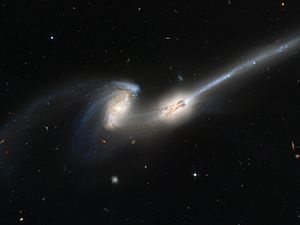Mice galaxies facts for kids
The Mice Galaxies are two amazing spiral galaxies that are crashing into each other! They are found in the constellation called Coma Berenices. These galaxies are about 290 million light-years away from us. We call them the Mice Galaxies because their long "tails" look a bit like mouse tails. These tails are made of stars and gas pulled away by gravity during their collision.
Contents
What are the Mice Galaxies?
The Mice Galaxies are officially known as NGC 4676. They are two spiral galaxies, which means they look like giant pinwheels spinning in space. Each galaxy is made up of billions of stars, along with gas and dust. They are part of a huge group of galaxies called the Coma Cluster. This cluster has thousands of galaxies, so collisions like this can happen often.
Why are they called "Mice"?
The name "Mice Galaxies" comes from their unique appearance. As the two galaxies pull on each other with their gravity, they stretch out long streams of stars and gas. These streams look like the long, thin tails of mice. Scientists call these tails "tidal tails."
How do tidal tails form?
Tidal tails happen because of something called tidal action. Imagine you have two magnets. If you bring them close, they pull on each other. Galaxies are like super-giant magnets because of their gravity. When two galaxies get close, the gravity of one galaxy pulls harder on the side of the other galaxy that is closer to it. It pulls less on the side that is farther away. This difference in gravitational pull stretches the galaxies, creating those long, wispy tails.
A Cosmic Collision
The Mice Galaxies are a perfect example of a galaxy collision happening right now. But don't imagine a car crash! Galaxy collisions are much slower and take millions of years.
What happens during a galaxy collision?
When galaxies collide, the stars inside them usually don't crash into each other. This is because stars are very, very far apart. Instead, the galaxies pass through each other. Their huge clouds of gas and dust can smash together, though. This can trigger new star birth as the gas gets squeezed. The gravity of each galaxy also pulls and stretches the other, changing their shapes.
The future of the Mice Galaxies
The Mice Galaxies have probably collided before, and they will keep colliding. Over millions of years, they will slowly merge into one much larger galaxy. This is a common process in the universe. Our own galaxy, the Milky Way, is expected to merge with the Andromeda Galaxy in billions of years!
Observing the Mice Galaxies
Scientists have studied the Mice Galaxies closely to understand how galaxies interact and merge.
Hubble's View
The Mice Galaxies were famously photographed in 2002 by the Hubble Space Telescope. The Hubble Space Telescope is a powerful telescope that orbits Earth. It takes incredibly clear pictures of space because it is above Earth's atmosphere, which can blur images. The pictures from Hubble helped scientists see the fine details of the tidal tails and the ongoing collision.


